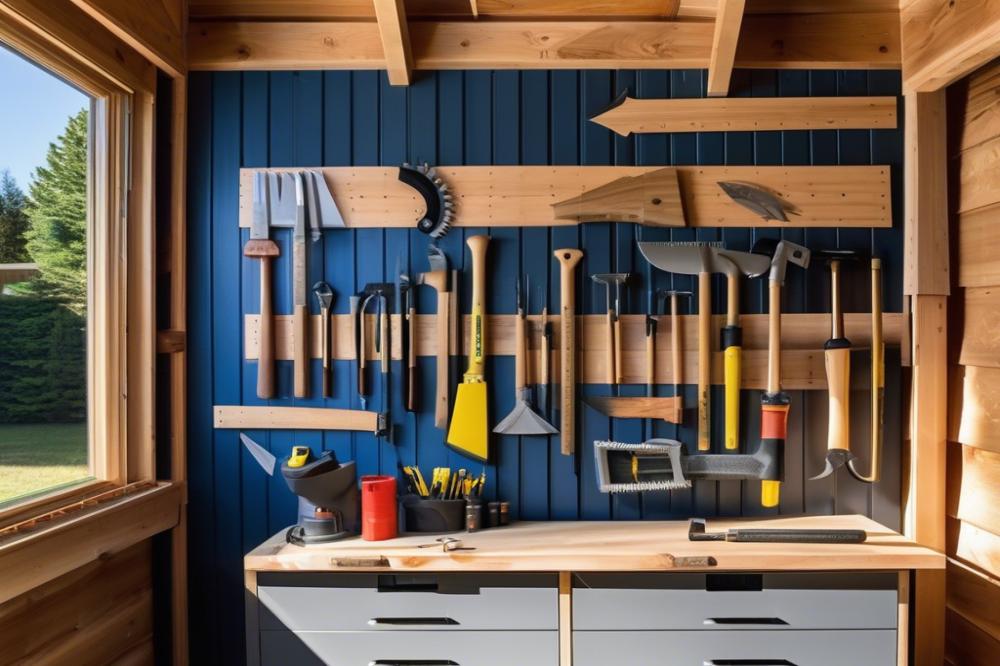Overview of the Importance of shed electricity
Adding electricity to your outdoor space can transform a simple shed into a versatile workspace or storage area. Many people use these structures for hobbies, gardening, or tools. With an electrical installation, this space gains functionality, making it easier to work and enjoy time inside. Having power allows for the use of various tools and lighting, which can enhance productivity.
Benefits of Adding Electricity to Your Shed
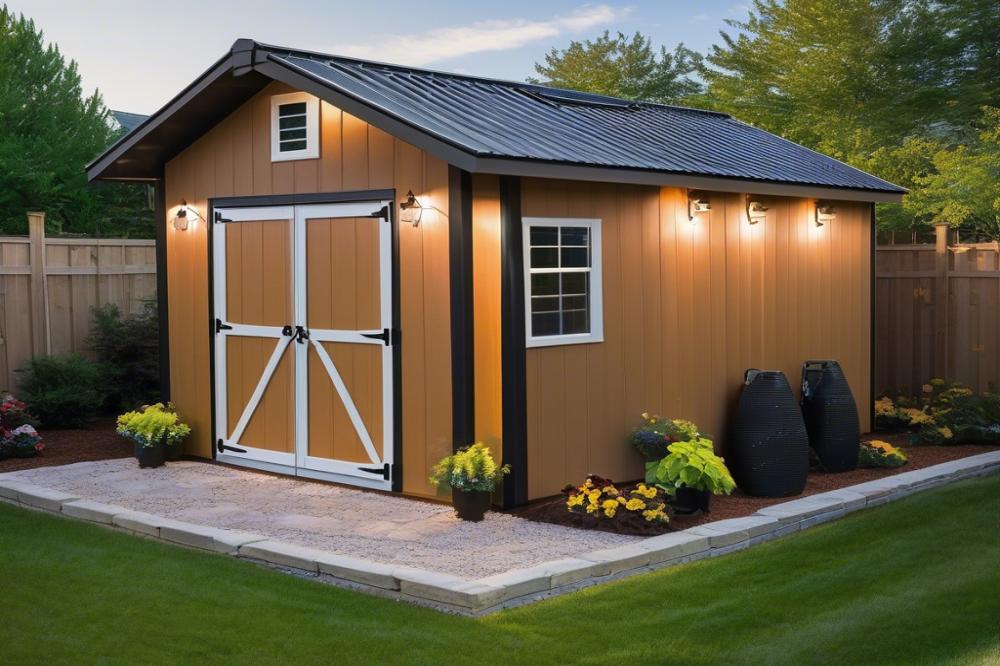
Electricity opens up numerous possibilities for shed use. Lighting solutions like brighter bulbs can illuminate the area, making it safer and more inviting. You can also power gadgets or equipment, reducing the hassle of relying on batteries or extension cords. A generator for shed power can be valuable for those who need backup energy options. Additionally, with proper shed insulation, climate control becomes achievable. This means more comfortable working conditions year-round.
Safety Considerations and Regulations
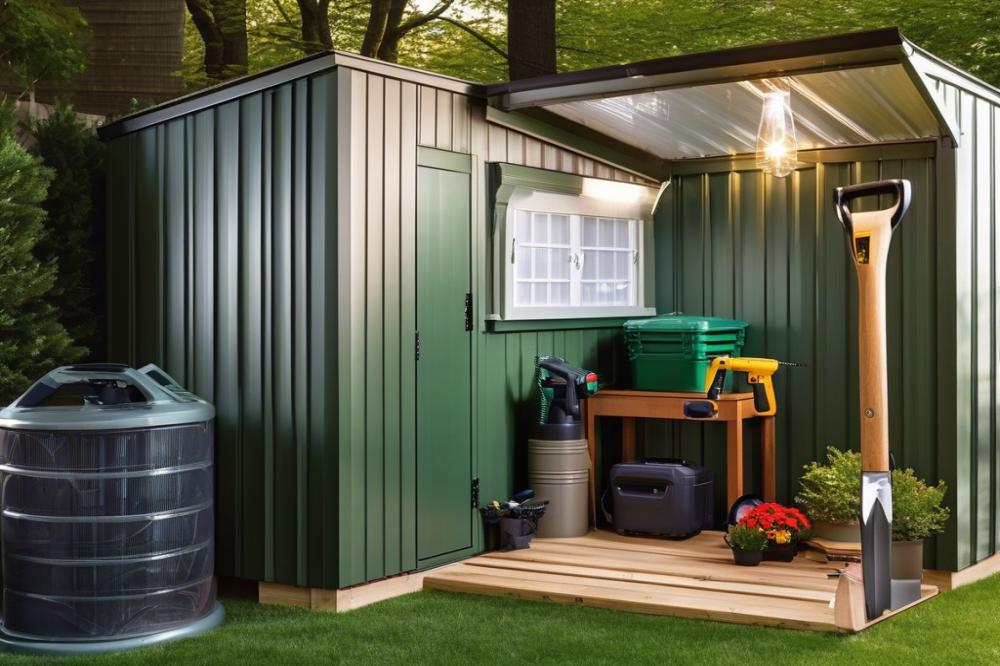
Safety should never be overlooked when considering an electrical upgrade. Familiarizing yourself with electrical codes is crucial, as non-compliance can create hazards. Installing waterproof outlets is important if your shed is near water sources. Always include circuit breakers to protect against potential overloads. Using safe wiring techniques ensures that everything functions without risk. For those inclined toward independence, DIY electrical projects can be rewarding but require caution. Always prioritize safety to maintain your shed’s functionality while avoiding accidents.
Understanding Electrical Codes
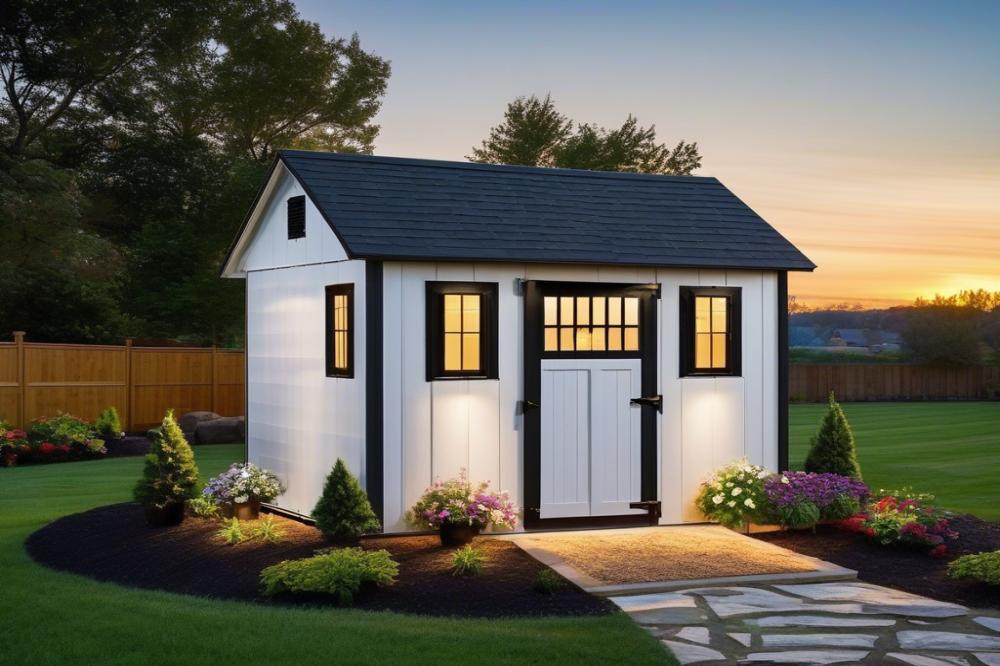
Electrical codes are essential guidelines that dictate how electricity should be installed and maintained in structures. These codes vary from one area to another, and they specify safety standards for outdoor structures like sheds. Knowing the regulations in your locality helps you avoid potential hazards.
Compliance with these rules is crucial for both safety and legality. Following the codes protects you from electrical fires or shocks. It also safeguards your investment, as improper installations can lead to costly repairs or fines. When you adhere to these standards, you create a safe environment for using your shed for various purposes.
Before starting any electrical installation, check if you need permits. Some jurisdictions require you to obtain these documents to ensure safe practices are followed. Inspections might also be necessary after the work is completed to verify everything meets the legal requirements. This process might seem tedious, but it is essential for your safety.
Consider the specifics of outdoor shed power when planning your project. Use waterproof outlets to protect against the elements, along with appropriate circuit breakers to avoid overloads. Thinking about lighting solutions that suit your needs will enhance visibility and usability, especially in darker conditions.
DIY electrical projects can be rewarding, but they must be approached with caution. Unit insulation in the shed helps regulate temperature and prevents condensation. Always prioritize safety during the installation and ensure each step adheres to the established electrical codes. Doing so gives peace of mind for you and anyone using the space.
Be careful with extension cords. These can lead to serious electrical issues if misused. A generator for shed might also be an option for powering tools or equipment, but it must be installed properly to avoid carbon monoxide risks. Strive for a combination of functionality and compliance for an effective electrical setup.
Planning Your Electrical Installation
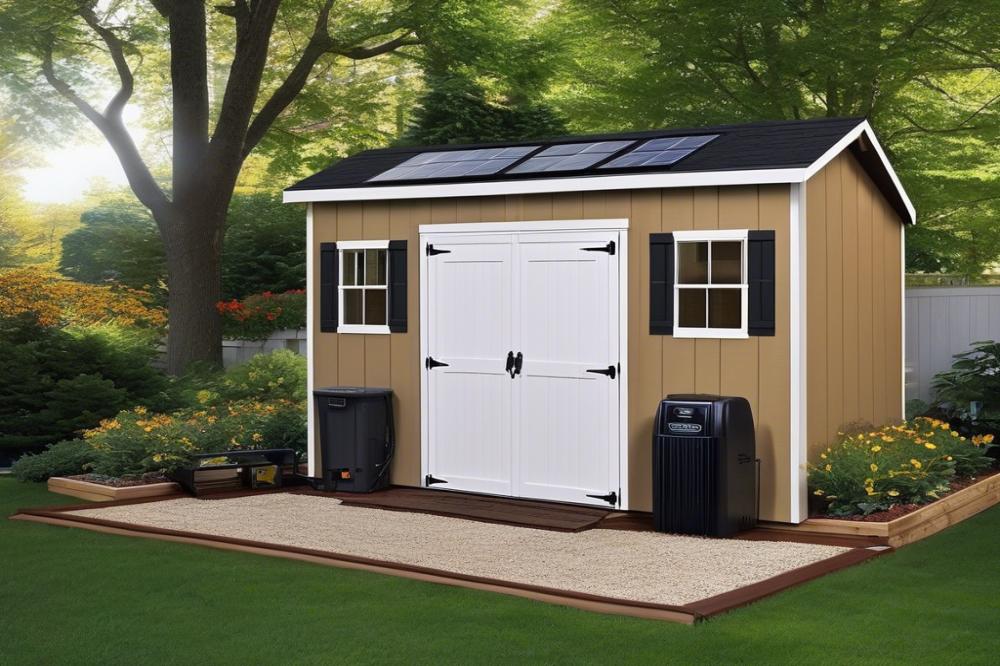
Assessing power needs for your shed is the first step. Think about what you want to power. Will there be lights, tools, or appliances? Each item uses a different amount of power. Make a list of your electrical devices. This helps to identify the overall wattage you’ll need.
Next, creating a layout for outlets, lighting, and appliances is crucial. Visualize where you want each component. Plan for multiple outlets to avoid using extension cords. Waterproof outlets are essential for outdoor conditions. Choose strategic locations for lights so that the shed is well-lit. Consider natural light too. It could reduce your energy needs.
When it comes to choosing the right electrical materials and components, quality is important. Not all wires are created equal. Look for options that meet electrical codes. Use a generator for shed power if you’re planning to work off-grid. Circuit breakers must be included for safety. They prevent overloads in the system. Don’t forget about proper shed insulation. This will help maintain a comfortable temperature.
For DIY electrical projects, take your time and gather all materials beforehand. A well-thought-out plan prevents mistakes and ensures safety. It’s advisable to review everything before starting, as it saves time and effort later. Knowledge about lighting solutions can guide you in making the right choices too.
Lastly, remember to double-check that your plan complies with local regulations. Not adhering to standards can lead to unsafe situations. Planning the electrical installation thoroughly can provide you with peace of mind.
Wiring Your Shed Safely
Running electrical wiring in your shed requires thoughtful planning. First, familiarize yourself with local electrical codes. These guidelines help ensure safety and compliance in your DIY electrical projects. Without following these regulations, you might face risks or penalties.
Choose your wiring carefully. Use a type called “UF” or underground feeder cable, which is suited for outdoor usage. This cable is durable and resistant to moisture. Many people overlook the importance of proper insulation in electrical installations. Proper shed insulation can enhance energy efficiency and reduce risks.
Next, install waterproof outlets. These outlets protect against rain and splashes. They are critical for maintaining safety if you plan to power tools or gadgets outside. Avoid using regular outlets in your shed. Waterproof options make a significant difference in preventing electrical hazards.
Outdoor Shed Power
Consider how much power your shed will need. Determine whether you will use a generator for shed power or connect to your home’s electrical system. If you utilize a generator, make sure to select one capable of handling your load. Planning for sufficient power supply helps prevent overloading.
When it comes to circuit breakers, understand their importance. They act as safety devices that cut off power in case of faults. Installing the correct circuit breaker can save you from potential electrical fires. Always select breakers that match the amperage of your wiring and devices.
While extension cords might be tempting for occasional use, they are not a permanent solution. Relying on them can lead to overloading and short-circuits, which create safety hazards. Fixed wiring is a much better choice for providing reliable power to your shed.
Lastly, think about your lighting solutions. Choose energy-efficient options, such as LED lights. These provide bright illumination while using less electricity. Incorporating proper lighting not only enhances usability but also helps in preventing accidents.
Lighting Solutions for Your Shed
Choosing the right lighting for your shed is crucial for safety and utility. Various options are available to illuminate these spaces effectively. LED lights are a popular choice due to their energy efficiency and long lifespan. Fluorescent lights can also be effective but may not offer the same longevity. For outdoor areas, consider motion-sensor lights. These activate when someone approaches, providing light only when needed. Finally, battery-powered lights can work well in areas without direct electrical installation.
Energy-efficient lighting solutions save money and reduce electricity usage. LEDs use significantly less power compared to traditional incandescent bulbs. They also produce less heat, making your shed cooler during hot months. Solar-powered lights are another eco-friendly alternative. These harness sunlight during the day to provide illumination at night. By opting for these options, you ensure your shed remains well-lit while keeping energy costs low.
Placement and Installation Tips for Optimal Lighting
Proper placement is key to effective lighting. Position lights near entry points to ensure visibility when approaching the shed. Place fixtures in corners to maximize coverage of the working area. Avoid setting lights too close to windows, as natural light can reduce the need for artificial illumination. Use waterproof outlets if you’re installing lights near an open area. They protect against moisture and keep connections safe.
When working on DIY electrical projects, adhere to local electrical codes. This helps guarantee safety and compliance with regulations. Installing circuit breakers can protect your lighting system from overloads. Even if you plan to use extension cords, they should not be the primary source of power. Consider using a generator for shed power if you need extra wattage during peak times. All these steps ensure a secure and functional lighting system.
Lastly, don’t forget about shed insulation. Proper insulation can help to manage temperature and protect your lighting setup. Combined, these tips will create a bright, functioning space that is safe and useful.
Power Options for Your Shed
Many homeowners consider various options when it comes to adding electricity to their sheds. Comparing outdoor shed power supply options starts with two main choices: grid power and generators. Connecting to the grid provides reliable electricity. However, this often involves more complicated electrical installation. Local electrical codes must be followed closely. On the other hand, a generator for shed use offers flexibility. It can be a temporary solution or even a permanent one if you prefer. Generators run on fuel, so they require maintenance and refueling. Choose one that fits your energy needs.
Temporary power needs may be met using extension cords. While these cords are convenient, safety is paramount. Look for heavy-duty options that are suitable for outdoor use. Avoid using lightweight cords that can easily become damaged. Keep cords away from moisture and debris. Waterproof outlets can greatly reduce risks. Position your cords carefully to minimize tripping hazards.
Many are exploring solar power systems as a sustainable alternative. This option is especially appealing to those who want to reduce their carbon footprint. Solar panels can be installed on the shed roof. They convert sunlight into electricity, allowing for unique energy independence. However, be aware of the upfront costs. Batteries will likely be needed for energy storage as well. Evaluate whether the available sunlight in your area supports this setup. Consider combining solar with traditional methods for added reliability.
When planning your electrical setup, think about shed insulation. Proper insulation will help maintain temperature and efficiency of lighting solutions. Efficient lighting will reduce the amount of energy needed, saving you money over time. A thoughtful approach to DIY electrical projects can not only enhance functionality but also improve safety. Circuit breakers are crucial for preventing overloads and protecting your equipment.
Insulating Your Shed for Energy Efficiency
Insulating your shed can significantly impact its overall temperature and comfort level. A well-insulated space stays warm in winter and cool in summer. This means that your tools, equipment, and any outdoor shed power solutions will remain in better condition for a longer time. Moreover, energy efficiency leads to lower energy bills by reducing the need for heating and cooling systems.
Choosing the right insulation can also affect safety. In any electrical installation, proper insulation helps minimize the risk of overheating. Without adequate insulation, temperature fluctuations can lead to damage in your tools or even malfunction in your generator for shed power. Circuit breakers will work more efficiently when the environment is consistent and predictable, lowering the chances of electrical fires.
Materials and Methods for Effective Insulation
One of the most common materials used for shed insulation is fiberglass batts. They are easy to install and can fill the gaps in your structure effectively. You might also consider foam boards for areas needing extra insulation. These options can block drafts and create a more stable environment.
Reflective insulation is another choice. It works by reflecting radiant heat, making it suitable for warm climates. When you start your DIY electrical projects, keeping the different insulation types in mind can save you time and money in the long run. Also, consider using waterproof outlets to protect any electrical components in your shed from moisture.
Installing insulation is typically straightforward. Start by measuring your walls and determining the best insulation type for your needs. Your local hardware store offers various options. Correct installation is crucial, so follow all recommended guidelines. Adhering to electrical codes will help you avoid any complications later on, especially if you’re adding lighting solutions or using extension cords extensively.
In summary, adding insulation is a smart move for any shed. It enhances the performance of your electrical setup while keeping your space comfortable. Furthermore, better insulation translates into significant energy savings, allowing you to focus more on your projects and less on utility bills.
DIY Electrical Projects vs. Hiring Professionals
Evaluating your skill set for DIY electrical projects
Many homeowners like to take on DIY electrical projects, especially when adding power to a shed. Knowing your skill level is important. If you are comfortable with tools and have a basic understanding of how electricity works, you might handle some tasks. Installing lighting solutions or adding waterproof outlets could be within your reach. However, simple tasks can turn complicated quickly. Mistakes can lead to safety hazards or damage. Check your local electrical codes to understand what is permissible. Remember, outdoor shed power may require special considerations.
When to hire a licensed electrician
Certain situations clearly call for a professional. If you’re unsure about any part of the installation process, seek help. Complex electrical installation involving circuit breakers or heavy-duty wiring is best left to experts. Hiring someone ensures that everything meets safety standards. A licensed electrician is familiar with local regulations. Their experience can save time and prevent dangerous errors. If the project involves a generator for shed power, don’t hesitate to call in an expert.
Common electrical mistakes to avoid
Electrical work requires precision and caution. One common mistake is using extension cords as permanent wiring, which poses risks. Another issue arises when people underestimate the need for shed insulation. Insufficient insulation can lead to energy loss and electrical failures. Not adhering to the correct amperage rating for circuit breakers is a frequent oversight. This can cause overloads, presenting a fire hazard. Finally, neglecting proper weatherproofing by failing to install waterproof outlets is a significant error.
Stay vigilant. Assess your abilities honestly before deciding on the best approach to adding electricity to your shed. Remember, safety should always come first.
Final Thoughts on Adding Electricity to Your Shed
Recapping the key points can help reinforce what we’ve discussed. First, it’s essential to plan your electrical installation carefully. This means deciding on the locations of outlets and lights before starting. Additionally, using outdoor-rated materials is a must for safety. Exposed wires or improper equipment can lead to dangerous situations.
Remember to check local codes and regulations. Compliance with these rules not only promotes safety but also makes future inspections easier. Your project won’t just be practical; it will be legal too. Hiring a qualified electrician is another smart choice if you feel unsure about your skills. Professional help can save time and minimize risks.
Always prioritize safety throughout the entire process. Use the right tools and wear appropriate safety gear. Do not overlook the importance of turning off power at the breaker when working. This simple action can significantly reduce the chances of accidents happening.
As you wrap up your project, consider the benefits of having outdoor shed power. With proper planning and execution, your space can become an electric haven for hobbies, storage, or workshops. Make sure to take your time. Rushing could result in mistakes where caution is required.
Finally, ensure every connection is secure and tested. Double-check your work before you start using power tools or any other electrical devices in your shed. A well-planned and executed project can lead to a safer and more enjoyable area to work and relax in.



